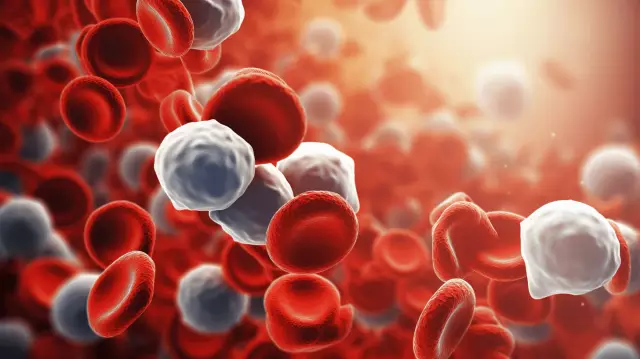- Author Curtis Blomfield [email protected].
- Public 2023-12-16 20:44.
- Last modified 2025-01-23 17:01.
Chronic myelogenous leukemia is a serious disease in which certain cells in the human bone marrow degenerate and become malignant. At the same time, a huge amount of pathologically altered granulocytes is produced in the blood. This dangerous disease can affect people of absolutely any age. But according to official statistics, the disease is rarely recorded in children under 10 years old.

Chronic myeloid leukemia is very difficult to detect in the early stages, as the disease is not accompanied by any specific symptoms. In some cases, patients complain of general fatigue, loss of appetite and weight. At night, sweating appears, the temperature rises. Heaviness and discomfort in the abdomen are noted, as a rule, this is caused by pathological changes in the spleen. There is also an increase in lymph nodes. If you ignore the first obscuresymptoms, then, unfortunately, it is impossible to identify the disease at the first stage.

This is the insidious chronic myeloid leukemia. The reasons for delayed treatment also lie in the latency of the course of the disease. Later symptoms of the disease already more clearly indicate the pathological process. The patient's condition deteriorates sharply. The number of platelets and red blood cells in the blood falls. The skin becomes pale, small blood vessels are easily injured. There are subcutaneous hemorrhages and extensive hematomas. The enlargement of the lymph nodes is more pronounced. Nodules form on the patient's skin, they are filled with leukemic granulocytes. This sign is especially worrisome and should be a sure sign to see a specialist.

Chronic myeloid leukemia mainly affects the bone marrow, liver and spleen. Most granulocytes are formed in these organs. In a normal person, cells at all stages of maturity are detected during the analysis. In acute myeloid leukemia, only immature forms are found. Pathological (malignant) granulocytes displace normal cells from the bone marrow. This in most cases leads to the formation of an ever-growing connective tissue that replaces the bone marrow. At the stage of acceleration, as the disease progresses, less and less mature cells enter the organ. Thrombocytopenia and anemia develop. Sometimes chronic myeloid leukemia progresses due to the fact that granulocytesundergo additional changes, and then the risk of developing a blast crisis in a patient increases. At the same time, only immature granulocytes are produced from reborn stem cells. The course of the disease with a blast crisis is aggravated.
Chronic myeloid leukemia is diagnosed using a standard blood test. It is able to detect a multiple increase in the number of leukocytes. For a more accurate diagnosis, a study of chromosomes is used. This method almost always detects the presence of chromosomal translocations with a high percentage of accuracy.






